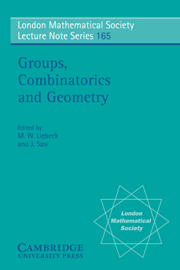Book contents
- Frontmatter
- Contents
- Authors' Addresses
- Introduction
- Part 1 Sporadic groups
- Part 2 Moonshine
- Part 3 Local and geometric methods in group theory
- 11 The classification of 3-transposition groups with trivial center
- 12 (S3,S6,)-Amalgams
- 13 Pushing down minimal parabolic systems
- 14 Nonspherical spheres
- 15 On the 2-local structure of finite groups
- 16 Groups generated by k-root subgroups – a survey
- Part 4 Geometries and related groups
- Part 5 Finite and algebraic groups of Lie type
- Part 6 Finite permutation groups
- Part 7 Further aspects of simple groups
- Part 8 Related topics
14 - Nonspherical spheres
Published online by Cambridge University Press: 07 September 2010
- Frontmatter
- Contents
- Authors' Addresses
- Introduction
- Part 1 Sporadic groups
- Part 2 Moonshine
- Part 3 Local and geometric methods in group theory
- 11 The classification of 3-transposition groups with trivial center
- 12 (S3,S6,)-Amalgams
- 13 Pushing down minimal parabolic systems
- 14 Nonspherical spheres
- 15 On the 2-local structure of finite groups
- 16 Groups generated by k-root subgroups – a survey
- Part 4 Geometries and related groups
- Part 5 Finite and algebraic groups of Lie type
- Part 6 Finite permutation groups
- Part 7 Further aspects of simple groups
- Part 8 Related topics
Summary
Let G be a finite simple group, p a prime, S a Sylow p-subgroup of G and let {P1,…, Pn} be a minimal parabolic system of G in the sense of. Then this parabolic system does not determine G uniquely. In fact in most cases there is even an infinite group having the same parabolic system. In this paper we will make an additional assumption which will hopefully make it possible to determine G in most cases. For this approach we will use the geometry γ associated to the parabolic system (The objects are the cosets of the maximal parabolics Gi = 〈Pj ∣ ≠ i〉, i = 1, …, n and incidence iff two different cosets have nontrivial intersection).
We will consider a geometry γ (firm, residually connected) over a finite type set I. Furthermore let G be a subgroup of Aut(γ) acting flag transitively on γ. Then we define
DefinitionA thin subgeometry Δ of Γ will be called an apartment in γ with respect to G iff
(1) I is also the type set of Δ.
(2) Δ is residually connected.
(3) N = GΔ (the setwise stabilizer of Δ in G) acts flag transitively on Δ.
We make the following observation: Suppose γ possesses an apartment Δ with GΔ = N. Let us fix a maximal flag F of Δ. Set B = GF Then we may choose notation such that where Fi are the comaximal flags in F. As N acts flag transitively on Δ we get that for any i there is a reflection xi on Fi Now obviously 〈x1, … xn〉 acts flag transitively on Δ. So by (2) we get that N = 〈x1, … xn〉 (B ∩ N).
Information
- Type
- Chapter
- Information
- Groups, Combinatorics and Geometry , pp. 151 - 158Publisher: Cambridge University PressPrint publication year: 1992
